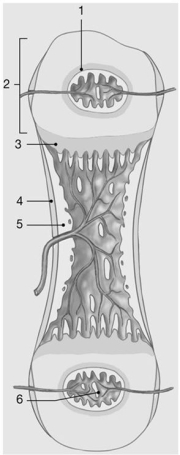A) Blue
B) Yellow
C) White
D) Gray
E) Red
G) A) and D)
Correct Answer

verified
Correct Answer
verified
Multiple Choice
Bones that are small, round and tend to develop in tendons are
A) long bones.
B) flat bones.
C) sesamoid bones.
D) short bones.
E) irregular bones.
G) B) and D)
Correct Answer

verified
Correct Answer
verified
Multiple Choice
What type of tissue is replaced in the embryo during endochondral ossification?
A) connective tissue membranes
B) fibrocartilage
C) mesenchymal tissue
D) hyaline cartilage
E) Wharton's jelly
G) A) and C)
Correct Answer

verified
Correct Answer
verified
Multiple Choice
A shallow depression on a bone is termed a
A) fossa.
B) sulcus.
C) facet.
D) fissure.
E) line.
G) None of the above
Correct Answer

verified
Correct Answer
verified
Multiple Choice
In a ________ fracture one side of the shaft is split and the other side is bent.
A) comminuted
B) greenstick
C) compression
D) transverse
E) spiral
G) A) and D)
Correct Answer

verified
Correct Answer
verified
Multiple Choice
When the epiphyseal plate is replaced by bone,
A) puberty begins.
B) interstitial bone growth begins.
C) appositional bone growth begins.
D) long bones have reached their adult length.
E) the bone becomes more brittle.
G) C) and D)
Correct Answer

verified
Correct Answer
verified
Multiple Choice
Which of the following statements about Marfan's syndrome is false?
A) It results in short, stubby fingers.
B) It results from a mutation.
C) It affects connective tissue structures.
D) It affects epiphyseal cartilages.
E) It may also cause cardiovascular problems.
G) B) and D)
Correct Answer

verified
Correct Answer
verified
Multiple Choice
Asmall rough bump on bone where a tendon attaches is called a
A) tubercle.
B) trochanter.
C) trochlea.
D) tuberosity.
E) trabecula.
G) B) and D)
Correct Answer

verified
Correct Answer
verified
Multiple Choice
Bone growth in length occurs by mitosis of
A) concentric lamellae.
B) cartilage cells in the epiphyseal side of the metaphysis.
C) growth of trabeculae.
D) osteoblasts in the endosteum.
E) cartilage cells in the diaphyseal side of the metaphysis.
G) D) and E)
Correct Answer

verified
Correct Answer
verified
Multiple Choice
________ bone reduces the weight of the skeleton and reduces the load on muscles.
A) Short
B) Irregular
C) Spongy
D) Compact
E) Long
G) B) and D)
Correct Answer

verified
Correct Answer
verified
Multiple Choice
Figure 6-2 Endochondral Ossification
 Use Figure 6-2 to answer the following question(s) :
-Identify the structure labeled "2."
Use Figure 6-2 to answer the following question(s) :
-Identify the structure labeled "2."
A) epiphysis
B) diaphysis
C) metaphysis
D) marrow cavity
E) trabeculae
G) C) and E)
Correct Answer

verified
Correct Answer
verified
Multiple Choice
Of the total organic components in bone most of it is
A) collagen.
B) keratin.
C) keratohyalin.
D) elastin.
E) actin.
G) D) and E)
Correct Answer

verified
Correct Answer
verified
Multiple Choice
A________ is a smooth, grooved bone process shaped like a pulley.
A) tubercle
B) trochanter
C) trochlea
D) tuberosity
E) trabeculae
G) C) and E)
Correct Answer

verified
Correct Answer
verified
Multiple Choice
Where in the body does the production of precursors for the synthesis of calcitriol occur?
A) bone
B) kidneys
C) small intestine
D) liver
E) skin
G) A) and D)
Correct Answer

verified
Correct Answer
verified
Multiple Choice
The adult skeleton contains ________ major bones.
A) 88
B) 115
C) 174
D) 206
E) 251
G) A) and C)
Correct Answer

verified
Correct Answer
verified
Multiple Choice
Bones that are boxy with approximately equal dimensions are
A) long bones.
B) flat bones.
C) sesamoid bones.
D) short bones.
E) irregular bones.
G) B) and E)
Correct Answer

verified
Correct Answer
verified
Multiple Choice
Which of the following is true of osteoclasts?
A) Osteoclasts maintain protein and mineral content of matrix.
B) Osteoclasts are responsible for laying down osteoid.
C) Osteoclasts form cytoplasmic extensions within canaliculi.
D) Osteoclasts are located within lacunae.
E) Osteoclasts secretes protein digesting enzymes and acids that dissolve matrix.
G) B) and C)
Correct Answer

verified
Correct Answer
verified
Multiple Choice
The interconnecting tiny arches of bone tissue found in spongy bone are called
A) osteons.
B) trabeculae.
C) concentric lamellae.
D) interstitial lamellae.
E) lacunae.
G) B) and D)
Correct Answer

verified
Correct Answer
verified
Multiple Choice
A calcified skeletal muscle is an example of
A) bone spurs.
B) osteoporosis.
C) heterotopic bone formation.
D) osteodysplasia.
E) osteomalacia.
G) C) and E)
Correct Answer

verified
Correct Answer
verified
Essay
Would you expect to see changes in blood levels of the hormones calcitonin and PTH as a result of vitaminD3deficiency? Explain.
Correct Answer

verified
A person deficient in vitamin D? would n...View Answer
Show Answer
Correct Answer
verified
View Answer
Showing 81 - 100 of 165
Related Exams